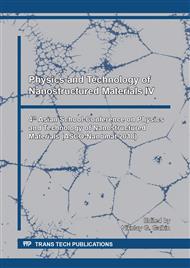[1]
D. Bresser, E. Paillard, S. Passerini, Lithium-ion batteries (LIBs) for medium- and large-scale energy storage: emerging cell materials and components, in: C. Menictas, M. Skyllas-Kazacos, T.M. Lim. (Eds.), Advances in Batteries for Medium and Large-Scale Energy Storage, Woodhead Publishing, Sawston, Cambridge, 2015, p.213.
DOI: 10.1016/b978-1-78242-013-2.00007-8
Google Scholar
[2]
S. Goriparti, E. Miele, F. De Angelis, E. Di Fabrizio, R.P. Zaccaria, C. Capiglia, Review on recent progress of nanostructured anode materials for Li-ion batteries, J. Power Sources 257 (2014) 421–443.
DOI: 10.1016/j.jpowsour.2013.11.103
Google Scholar
[3]
A.B. Yaroslavtsev, T.L. Kulova, A.M. Skundin, Electrode nanomaterials for lithium-ion batteries, Russ. Chem. Rev. 84 (2015) 826–852.
DOI: 10.1070/rcr4497
Google Scholar
[4]
Y.-H. Sun, S. Liu, F.-C. Zhou, J.-M. Nan, Electrochemical performance and structure evolution of core-shell nano-ring α-Fe2O3/carbon anodes for lithium-ion batteries, Appl. Surf. Sci. 390 (2016) 175–184.
DOI: 10.1016/j.apsusc.2016.08.071
Google Scholar
[5]
N.K. Chaudhari, M.-S. Kim, T.-S. Bae, J.-S. Yu, Hematite (α-Fe2O3) nanoparticles on vulcan carbon as an ultrahigh capacity anode material in lithium ion battery, Electrochem. Acta 114 (2013) 60–67.
DOI: 10.1016/j.electacta.2013.09.169
Google Scholar
[6]
Y. Zeng, W. Zhang, C. Xu, N. Xiao, Y. Huang, D.Y.W. Yu, H.H. Hng, Q. Yan, One‐step solvothermal synthesis of single‐crystalline TiOF2 nanotubes with high lithium‐ion battery performance, Chem. Eur. J. 18 (2012) 4026–4030.
DOI: 10.1002/chem.201103879
Google Scholar
[7]
P.E. Meskin, D.R. Afanas'ev, A.I. Gavrilov, B.R. Churagulov, N.N. Oleinikov, A.E. Baranchikov, V.K. Ivanov, Ultrasonically activated hydrothermal synthesis of fine TiO2 and ZrO2 powders, Inorg. Mater. 40 (2004) 1058–1065.
DOI: 10.1023/b:inma.0000046468.73127.f5
Google Scholar
[8]
S.V. Gnedenkov, D.P. Opra, S.L. Sinebryukhov, V.G. Kuryavyi, А.Yu. Ustinov, V.I. Sergienko, Structural and electrochemical investigation of nanostructured C:TiO2–TiOF2 composite synthesized in plasma by an original method of pulsed high-voltage discharge, J. Alloy. Compd. 621 (2015).
DOI: 10.1016/j.jallcom.2014.10.023
Google Scholar


